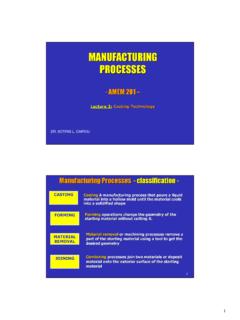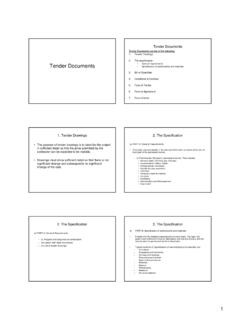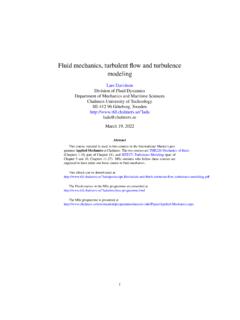Transcription of POWER SCREWS (ACME THREAD) DESIGN - FIT
1 AMEM 316: Machine Elements I POWER SCREWS (ACME THREAD) DESIGN There are at least three types of POWER screw threads: the square thread, the Acme thread, and the buttress thread. Of these, the square and buttress threads are the most efficient. That is, they require the least torque to move a given load along the screw. However, the Acme thread is not greatly less efficient, and it is easier to machine. The buttress thread is desirable when force is to be transmitted in only one direction. As with fasteners, manufacturers have developed preferred combinations of basic major diameter, D, and number of threads per inch, n, for Acme screw threads.
2 The pitch, p, is the distance from a point on one thread to the corresponding point on the adjacent thread, and p = 1ln. Other pertinent dimensions documented include the minimum minor diameter and the minimum pitch diameter of a screw with an external thread. When you are performing stress analysis on the screw, the safest approach is to compute the area corresponding to the minor diameter for tensile or compressive stresses. However, a more accurate stress computation results from using the tensile stress area, found from 224 + =prtDDA This is the area corresponding to the average of the minor (or root) diameter, , and the pitch diameter.
3 The data reflect the minimums for commercially available SCREWS according to recommended tolerances. rDpD The shear stress area. , is also found in published data and represents the area in shear approximately at the pitch line of the threads for a length of engagement. Other lengths would require that the area be modified by the ratio of the actual length to in. sA When using a POWER screw to exert a force, as with a jack raising a load, you need to know how much torque must be applied to the nut of the screw to move the load. The parameters involved are the force to be moved, F; the size of the screw, as indicated by its pitch diameter, ; the lead of the screw, L; and the coefficient of friction.
4 Note that the lead is defined as the axial distance that the screw would move in one complete revolution. For the usual case of a single-threaded screw, the lead is equal to the pitch and for the usual case of the single-threaded screw can be computed from . pDfnpL/1== The torque to move a load up the thread is + =LfDDfLDFT pppu2 This equation accounts for the force required to overcome friction between the screw and the nut in addition to the force required just to move the load. If the screw or the nut bears against a stationary surface while rotating, there will be an additional friction torque developed at that surface.
5 For this reason, many jacks and similar devices incorporate antifriction bearings at such points. The coefficient of friction depends on the materials used and the manner of lubricating the screw. For well-lubricated steel SCREWS acting in steel nuts, = should be conservative. ff An important factor in the analysis for torque is the angle of inclination of the plane. In a screw thread, the angle of inclination is referred to as the lead angle, . It is the angle between the -1-AMEM 316: Machine Elements I tangent to the helix of the thread and the plane transverse to the axis of the screw.
6 PDL = tan where = circumference of the pitch line of the screw pD Then if the rotation of the screw tends to raise the load (move it up the incline), the friction force opposes the motion and acts down the plane. Conversely, if the rotation of the screw tends to lower the load, the friction force will act up the plane. The torque analysis changes: + =LfDLDfDFTpppd2 If the screw thread is very steep (that is, if it has a high lead angle), the friction force may not be able to overcome the tendency for the load to "slide" down the plane, and the load will fall due to gravity. In most cases for POWER SCREWS with single threads, however, the lead angle is rather small, and the friction force is large enough to oppose the load and keep it from sliding down the plane.
7 Such a screw is called self-locking, a desirable characteristic for jacks and similar devices. Quantitatively, the condition that must be met for self-locking is >tanf The coefficient of friction must be greater than the tangent of the lead angle. For = , the corresponding value of the lead angle is . For = , for very smooth, well-lubricated surfaces, the lead angle for-self-locking is . ff Efficiency for the transmission of a force by a POWER screw can be expressed as the ratio of the torque required to move the load without friction to that with friction. Letting = 0, the torque required without friction, , is f' T =2 LFT' Then the efficiency, e, is uTLFTe ==2u' T If the torque required to rotate the screw is applied at a constant rotational speed, n, then the POWER in horsepower to drive the screw is 63000nTP = The required tensile stress area for a screw loaded in tension is utSFA= where F = load to be moved; uS = tensile strength limit.
8 -2-AMEM 316: Machine Elements I A screw in some applications carries a load transverse to its axis. Such loads produce bending moments in the screw, which result in the development of bending stresses. To determine the required section modulus, S, for such an application uSMSmax= Long POWER SCREWS loaded in compression can fail by elastic instability as given by the Euler formula 22 =rbECAF where F = total load, A = area of section, E = modulus of elasticity, b/r = slenderness ratio, and С is the coefficient of constraint, which depends on end conditions. For round ends, С = 1; for fixed ends, С = 4; and for the end conditions that occur in practice, С can rarely be assumed greater than 2.
9 For POWER SCREWS that behave as short columns, it is not possible to calculate with accuracy the maximum stress produced by a nominally concentric load because of the large influence of the indeterminate crookedness and eccentricity. The maximum unit stress that a column will sustain, however, can be expressed by any of a number of formulas, each of which contains one or more terms that is empirically adjusted to secure conformity with test results. Of such formulas, those given below are the best known and provide the basis for most of the DESIGN formulas used in American practice.
10 In these equations F denotes the load at failure, A the cross-sectional area, b the length, and r the least radius of gyration of the section; the meaning of other symbols used is explained in the discussion of each formula. Rankine formula 21 + =rLAP This is a semirational formula. The value of -is sometimes taken as the ultimate strength of the material and the value of as , thus making the formula agree with the results of tests on short prisms when L/r is very small and with Euler's equation when L/r is very large. More often and are adjusted empirically to make the equation agree with the results of tests through the L/r range of most importance.









